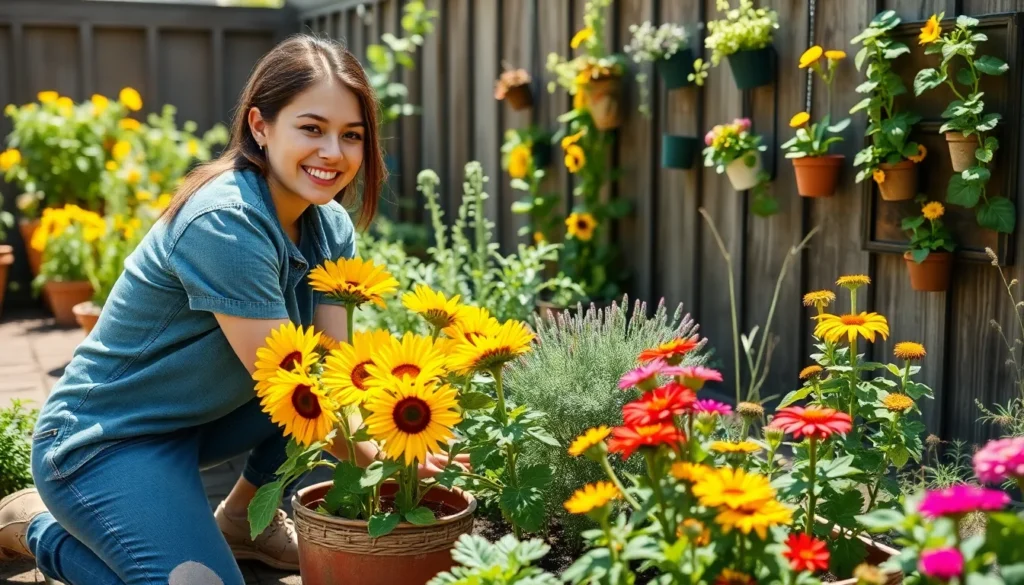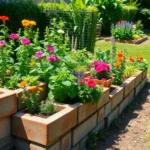We’ve all dreamed of having a beautiful garden but worried about the costs adding up quickly. The good news? Creating a stunning small garden doesn’t require very costly or having acres of space to work with.
Whether you’re working with a tiny backyard, balcony, or even just a windowsill, we’ll show you how to transform any small space into a thriving garden paradise. Smart planning and creative thinking can stretch your budget further than you’d imagine.
From repurposing household items as planters to choosing the right plants that give maximum impact for minimal cost, there are countless ways to create your dream garden without overspending. We’re about to share proven strategies that’ll help you grow more while spending less, turning your gardening aspirations into an affordable reality.
Start With Seeds Instead of Plants
Starting from seeds transforms our gardening budget dramatically. We’ll save 80-90% compared to purchasing established plants while gaining access to countless varieties unavailable in nurseries.
Choose Fast-Growing Vegetables
Radishes sprout in just 3-4 days and mature within 30 days, making them perfect for instant gratification. We recommend varieties like Cherry Belle or French Breakfast for beginners seeking quick results.
Lettuce seeds germinate within a week and provide continuous harvests throughout the growing season. Buttercrunch and Black Seeded Simpson varieties thrive in containers and small spaces.
Spinach grows rapidly in cool weather and produces leaves ready for harvest in 40-50 days. Baby Leaf and Space varieties work exceptionally well in window boxes or compact garden beds.
Bush beans eliminate the need for trellises while producing pods in 50-60 days. Provider and Contender varieties offer high yields in minimal space.
| Vegetable | Days to Germination | Days to Harvest | Seed Cost per Packet |
|---|---|---|---|
| Radishes | 3-4 days | 30 days | $2-3 |
| Lettuce | 7 days | 45 days | $2-4 |
| Spinach | 7-14 days | 40-50 days | $3-5 |
| Bush Beans | 7-10 days | 50-60 days | $3-6 |
Select Easy-to-Grow Flowers
Sunflowers require minimal care and produce stunning blooms from seed in 70-100 days. Mammoth and Dwarf varieties adapt to different space constraints while attracting beneficial pollinators.
Zinnias bloom continuously from summer through frost with virtually no maintenance required. State Fair Mix and Thumbelina varieties offer diverse colors and heights for visual interest.
Marigolds repel garden pests naturally while providing vibrant orange and yellow flowers. French and Signet varieties work well in containers and border plantings.
Cosmos self-seed readily, ensuring beautiful displays year after year with minimal investment. Sensation Mix and Bright Lights varieties create airy, delicate textures in our gardens.
Morning glories climb rapidly to create privacy screens and vertical interest. Heavenly Blue and Grandpa Ott varieties produce stunning trumpet-shaped flowers throughout the season.
Save Money on Herb Gardens
Basil seeds cost under $3 per packet yet produce enough plants to supply fresh herbs all season. Genovese and Purple Ruffles varieties offer different flavors and visual appeal.
Cilantro bolts quickly in heat, making succession planting from seeds more economical than buying plants repeatedly. Slow Bolt and Santo varieties extend our harvest window significantly.
Parsley grows as a biennial, providing two years of harvests from a single seed investment. Flat-leaf and curly varieties serve different culinary purposes in our kitchens.
Dill self-seeds prolifically, establishing patches that return annually without replanting costs. Fernleaf and Mammoth varieties offer compact and traditional growth habits respectively.
Oregano spreads naturally through underground runners, multiplying our initial seed investment into multiple plants. Greek and Mexican varieties provide distinct flavor profiles for cooking.
Repurpose Household Items as Planters
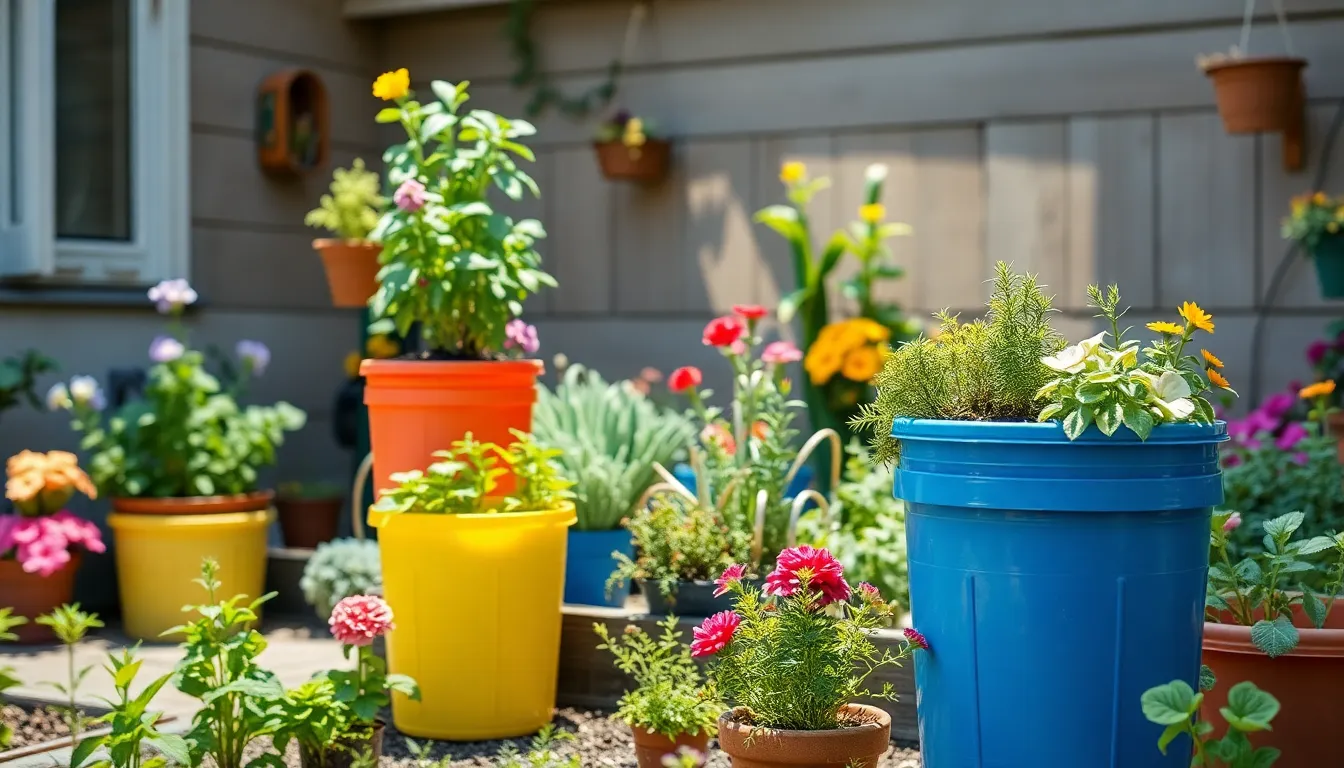
Building on our seed starting success, we can dramatically cut costs by transforming everyday household items into functional planters. This creative approach not only saves money but also reduces waste while adding unique character to our small garden spaces.
Transform Old Containers Into Garden Pots
Terra cotta pots work beautifully when arranged in tiered displays to maximize our vertical growing space while showcasing colorful flowers throughout the seasons. We’ve found that plastic buckets from dollar stores make excellent tiered herb planters when stacked and secured properly, creating both functional and decorative garden features for under $10.
Old dressers can be converted into charming potting supply benches, providing storage for our gardening tools while serving as unique display areas for smaller plants. Vinyl gutters offer perfect growing conditions for small herbs like thyme, oregano, and chives, especially when mounted along fences or walls to save precious ground space.
Wheelbarrows become stunning focal points when we drill drainage holes in the bottom and fill them with seasonal flowers or cascading plants like petunias and trailing nasturtiums.
Use Plastic Bottles for Vertical Growing
Plastic bottles provide an excellent solution for vertical gardening when we cut them in half and attach them to wooden boards or fence panels. This method works particularly well for growing lettuce, spinach, and small herbs in tight spaces like balconies or narrow side yards.
We can create impressive living walls by securing 2 liter bottles horizontally to lattice panels, ensuring each bottle has adequate drainage holes to prevent root rot. Clear bottles allow us to monitor root development, while darker containers protect roots from excessive light exposure.
Convert Wooden Crates Into Raised Beds
Wooden crates transform into perfect raised garden beds when we line them with industry fabric and add proper drainage materials at the bottom. These elevated planters improve soil drainage significantly compared to ground level planting, which proves especially beneficial for root vegetables like carrots and radishes.
We can stack multiple crates to create tiered growing systems that maximize our planting area while keeping maintenance tasks at comfortable working heights. Wine crates work exceptionally well for this purpose, offering sturdy construction and attractive weathered aesthetics that complement any garden style.
Create Your Own Compost System
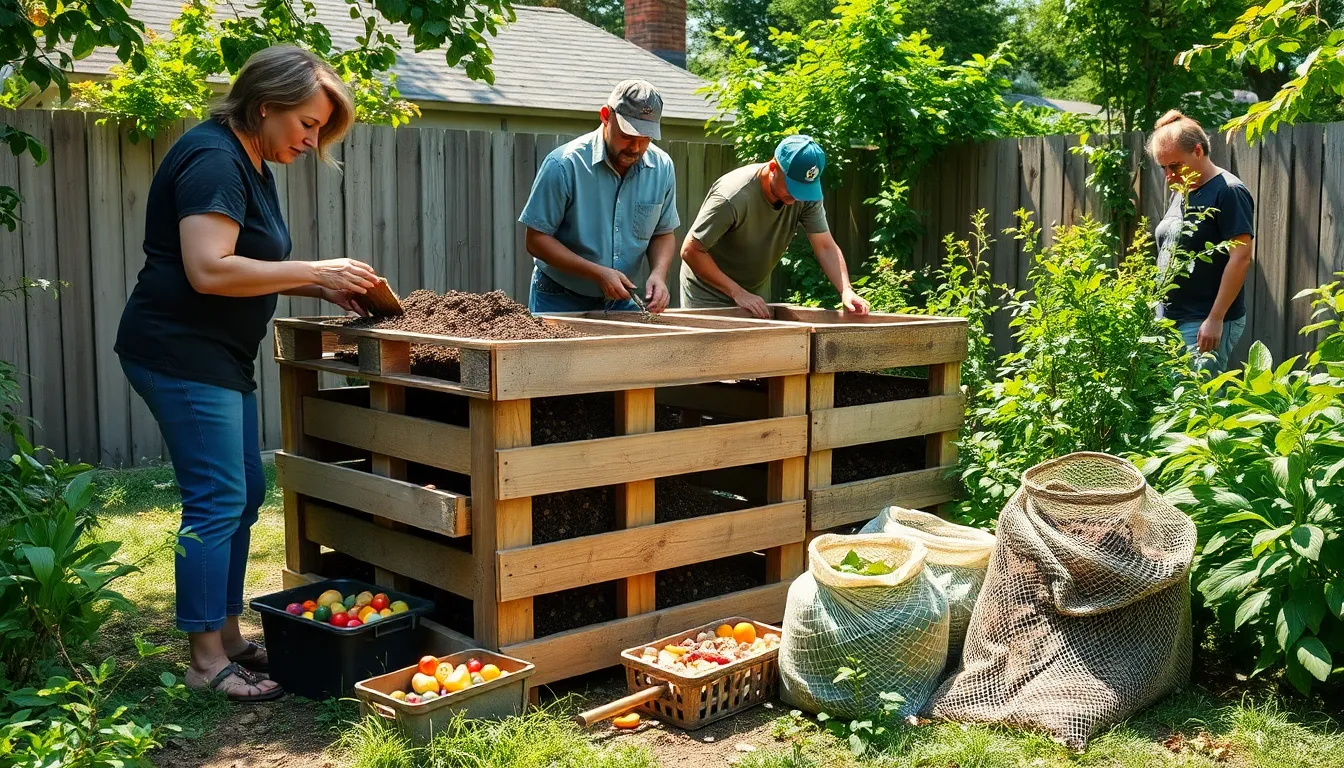
Composting transforms our kitchen scraps and yard waste into nutrient-rich soil amendment while saving money on fertilizers. This sustainable practice reduces household waste by up to 30% and creates free organic matter for our small garden spaces.
Build a Simple Three-Bin Composter
Wooden pallets offer an affordable foundation for constructing a three-bin composting system that costs under $50. We can secure four pallets together using zip ties or screws to create the first bin where fresh materials begin decomposition.
Setting up separate bins allows us to manage different stages of composting efficiently. The first bin holds new materials we add weekly, while the second bin contains materials that have been decomposing for several months. Our third bin stores finished compost that’s ready to enrich our garden soil.
Positioning the bins in a partially shaded area helps maintain proper moisture levels without excessive drying. We should ensure easy access for turning materials and harvesting finished compost from our three-stage system.
Start Small With Kitchen Scrap Composting
Vegetable peels, coffee grounds, and eggshells provide excellent green materials for our beginner composting efforts. We can collect these nitrogen-rich scraps in a small container on our kitchen counter before transferring them to our outdoor compost bin.
Avoiding meat, dairy, and oily foods prevents attracting pests and creating unpleasant odors in our small garden compost system. Fruit scraps like banana peels and apple cores decompose quickly and add valuable nutrients to our developing compost mixture.
Chopping larger scraps into smaller pieces accelerates decomposition and helps us achieve finished compost in 3-6 months instead of a full year. We can use kitchen shears or a knife to break down items like corn cobs and thick vegetable stems.
Use Fallen Leaves as Brown Material
Autumn leaves provide essential carbon-rich brown material that balances the nitrogen from our kitchen scraps. We should aim for a 3:1 ratio of brown to green materials to create optimal composting conditions and prevent odor issues.
Shredding leaves with a lawn mower or by running them through a leaf shredder creates smaller pieces that decompose faster. These broken-down leaves mix more easily with our green materials and improve air circulation throughout the compost pile.
Storing extra leaves in mesh bags or a designated area gives us brown material to add throughout the year when we have excess kitchen scraps. We can layer these leaves between green materials to maintain proper carbon-nitrogen balance in our budget-friendly composting system.
Focus on High-Yield Plants
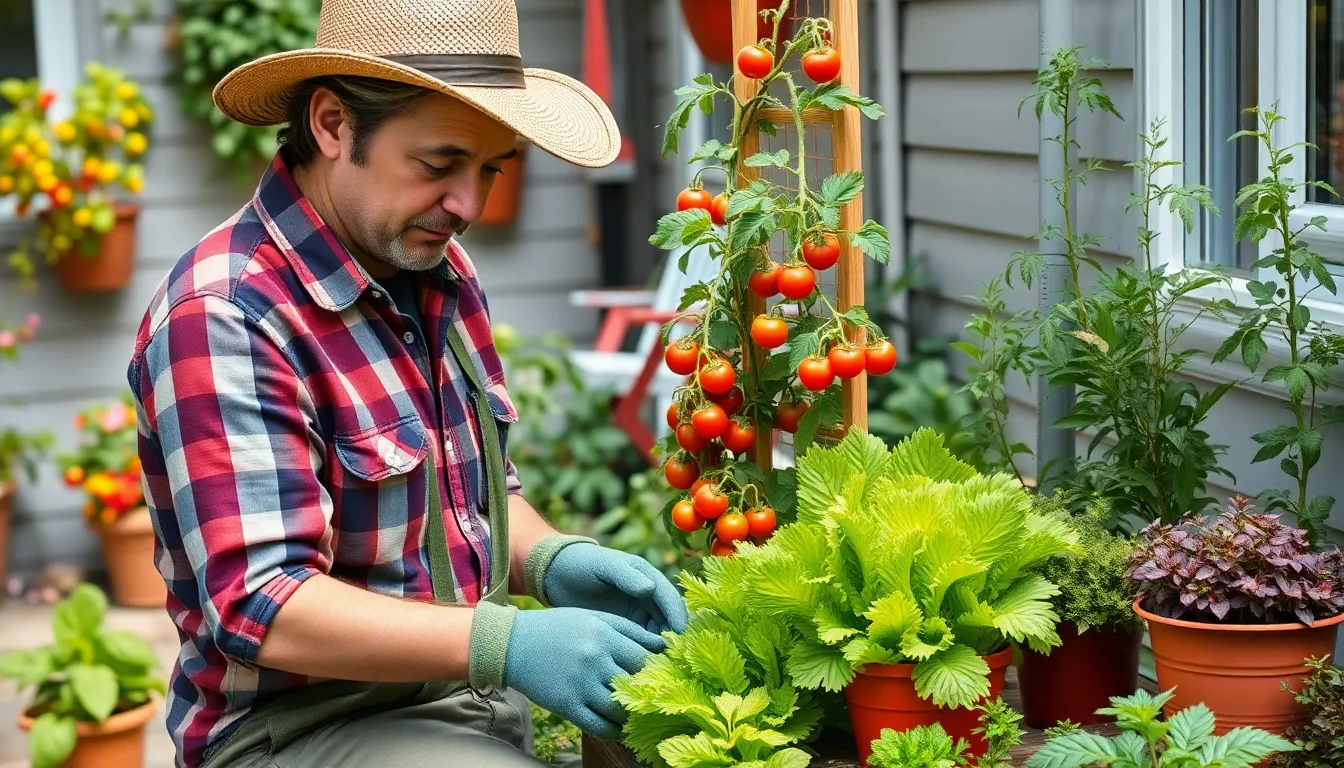
Maximum garden productivity comes from selecting plants that deliver abundant harvests in minimal space. We’ll maximize our small garden investment by choosing varieties that produce continuously throughout the growing season.
Grow Tomatoes in Small Spaces
Cherry tomatoes offer exceptional productivity for budget-conscious gardeners with limited space. ‘Sungold’ cherry tomatoes produce hundreds of sweet fruits per plant while requiring only 2-3 square feet of ground space. We recommend using vertical growing methods like trellises, cages, or tomato ladders to train plants upward rather than outward.
Compact patio tomato varieties thrive in containers as small as 5 gallons, making them perfect for balconies and small patios. These determinate varieties stop growing at a manageable height while still producing full-sized harvests. Support systems cost less than $10 per plant and can be reused for multiple seasons.
Plant Lettuce for Continuous Harvest
Successive planting ensures we’ll have fresh salad greens available throughout the growing season. Sowing new lettuce seeds every 1-2 weeks creates a continuous supply that prevents feast-or-famine harvesting cycles. We can plant different varieties simultaneously to extend our harvest window and add visual interest to garden beds.
Loose-leaf lettuce varieties like ‘Black Seeded Simpson’ and ‘Oak Leaf’ allow for cut-and-come-again harvesting over 6-8 weeks per planting. These varieties grow quickly from seed to harvest in just 30-45 days, making them ideal for multiple plantings per season. Each packet of seeds costs $2-3 and can produce dozens of plants worth $30-40 at grocery store prices.
Choose Herbs That Multiply Quickly
Basil and mint provide exceptional value for small garden budgets because they spread rapidly and produce continuous harvests. We can encourage bushy growth by pinching off flower buds regularly, which redirects plant energy into leaf production. These herbs can be harvested weekly once established, providing fresh ingredients that would cost $3-5 per week at grocery stores.
Chives and parsley offer additional multiplication benefits because they can be divided and replanted to create new plants. Mature chive clumps can be split into 4-6 new plants every 2-3 years, effectively multiplying our initial investment. Parsley readily self-seeds in favorable conditions, creating volunteer plants that expand our herb garden naturally without additional seed purchases.
Build Raised Garden Beds From Recycled Materials
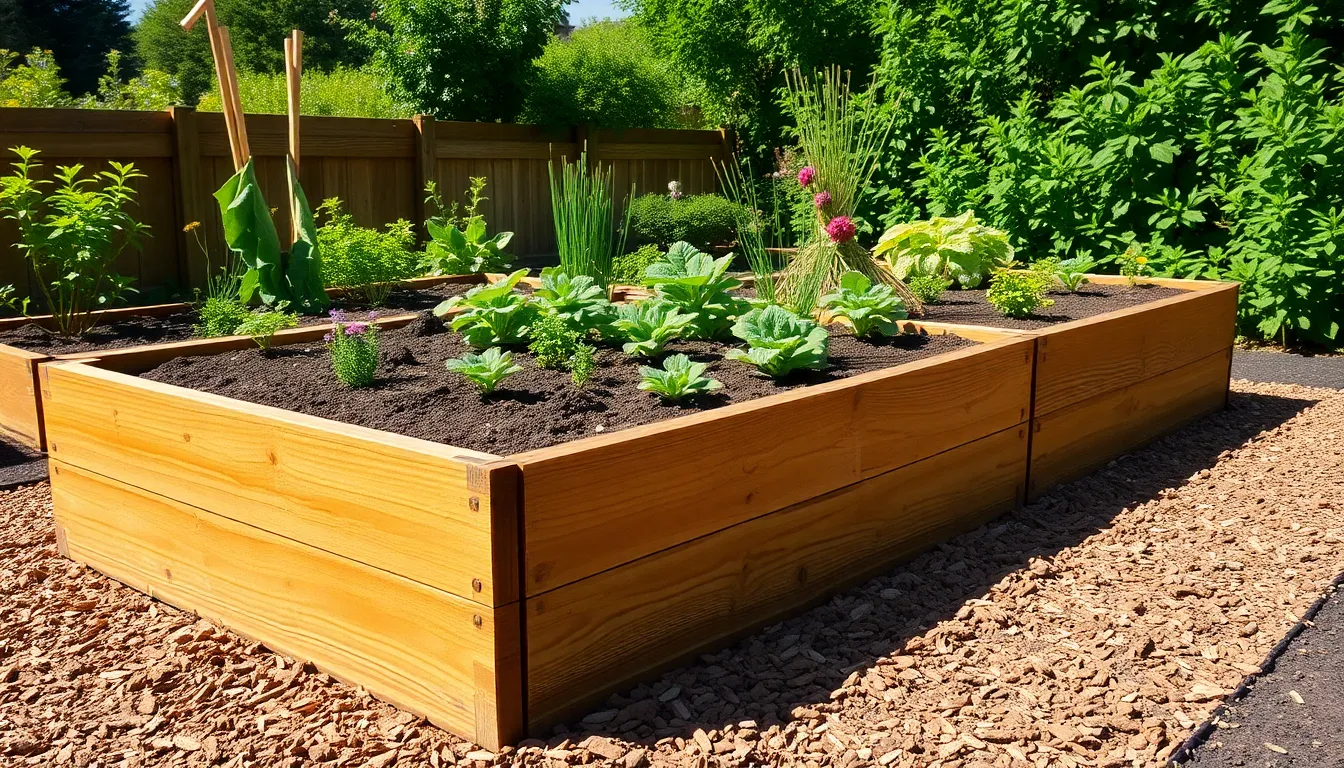
Transforming discarded materials into functional garden beds offers one of the most cost-effective ways to maximize our small growing spaces. We can create sturdy raised beds while keeping expenses minimal by sourcing materials that would otherwise end up in landfills.
Use Reclaimed Wood for Construction
Reclaimed wood provides the perfect foundation for budget-friendly raised beds that can last for years. We’ll find excellent options at local salvage yards where weathered barn wood and old fence posts often cost 50-70% less than new lumber. Construction pallets offer another fantastic resource – many businesses give them away for free since they’d otherwise pay disposal fees.
Old wooden crates from farmers markets or grocery stores work exceptionally well for smaller raised beds. We can reinforce these containers with additional corner supports if needed. Dismantled decking materials also make excellent bed sides, especially cedar or redwood that naturally resist rot and insects.
Before using any reclaimed wood, we should inspect it carefully for nails, splinters, or chemical treatments. Sanding rough surfaces prevents injuries and creates a more polished appearance for our garden beds.
Fill Beds With Free or Cheap Soil Amendments
Kitchen scraps transform into nutrient-rich compost that dramatically improves our soil quality without purchasing expensive fertilizers. Vegetable peels, coffee grounds, and eggshells break down into valuable organic matter that plants absolutely love. We’ll save hundreds of dollars annually by composting these materials instead of buying commercial soil amendments.
Leaf mold from our own yard provides another cost-free soil enhancer that retains moisture beautifully. Fallen leaves decompose into a dark, crumbly material that improves soil structure and feeds beneficial microorganisms. Local tree services often deliver wood chips and shredded leaves for free since they need disposal sites.
Grass clippings mixed into our raised beds add nitrogen while helping retain soil moisture. We can also contact local horse farms or stables for aged manure, which many owners gladly share with gardeners.
Create Pathways With Mulch or Gravel
Mulch pathways between our raised beds suppress weeds naturally while maintaining moisture levels in surrounding soil. Tree trimming services typically provide wood chips at no cost since they need convenient dumping locations. We’ll spread these chips 2-3 inches thick to create professional-looking walkways that require minimal maintenance.
Gravel offers a more permanent pathway solution that costs significantly less than concrete or pavers. Pea gravel or crushed stone creates attractive, well-draining surfaces that prevent muddy conditions during rainy seasons. Local quarries often sell gravel by the truckload at wholesale prices.
Recycled brick or broken concrete pieces can form charming rustic pathways when arranged creatively. Construction sites sometimes allow removal of these materials that would otherwise require expensive disposal fees.
Take Advantage of Free Resources

Building on these cost-saving techniques, we can tap into many free resources that transform our small gardens without spending a dime.
Find Free Plants Through Community Swaps
Community plant swaps offer incredible opportunities to expand our gardens while connecting with fellow gardeners. Local gardening groups organize these events where we exchange plants, cuttings, and bulbs with neighbors who share our passion for growing. Facebook community groups and neighborhood associations frequently host seasonal plant swaps in spring and fall.
We’ll discover rare varieties and native plants that might otherwise cost $15-30 each at nurseries. Master gardener programs at extension offices often coordinate these exchanges, bringing together experienced growers who share their knowledge alongside their plants. Libraries and community centers also host swap events where we can trade our excess seedlings for established perennials.
Collect Seeds From Existing Gardens
Seed collection from existing gardens provides us with free plants for next season while preserving varieties we love. We can gather seeds from mature flowers like sunflowers, zinnias, and marigolds in late summer when seed heads dry completely. Herb seeds from basil, cilantro, and dill plants offer easy harvests that save money on future plantings.
Timing becomes crucial since we need to collect seeds at peak ripeness before they scatter naturally. Paper envelopes work perfectly for storing collected seeds when labeled with variety names and collection dates. Friends and family members with established gardens often welcome help harvesting seeds in exchange for sharing the bounty.
Source Free Mulch From Local Tree Services
Tree service companies provide excellent sources of free wood chips and mulch that would otherwise cost $40-60 per cubic yard. We can contact local arborists who appreciate having convenient disposal locations for their chipped materials. Municipal parks departments often maintain free mulch piles available to residents throughout the growing season.
This organic mulch suppresses weeds effectively while retaining soil moisture and gradually improving soil structure as it decomposes. Fresh wood chips work best around trees and shrubs, while aged mulch suits vegetable gardens and flower beds better. Electric utility companies also generate wood chips from tree trimming operations and frequently offer free pickup locations.
Design Vertical Growing Solutions

Maximizing our vertical space transforms even the smallest garden areas into productive growing environments. We can use walls and fences to support plants while reducing the need for extensive horizontal space.
Install Wall-Mounted Planters
Wall-mounted planters save precious floor space while creating stunning visual displays for our herbs, succulents, and flowers. We can create these planters from recycled materials like old plastic bottles or wooden crates to keep costs minimal. Repurposed tin cans work exceptionally well for growing culinary herbs like basil and cilantro near our kitchen windows. These vertical answers provide easy access for daily harvesting while adding greenery to otherwise unused wall surfaces.
Securing planters to sturdy fence posts or exterior walls ensures they’ll support plant weight as our gardens mature. We should select lightweight potting mix to reduce overall planter weight and prevent structural strain on mounting hardware.
Create Trellis Systems for Climbing Plants
Trellis systems support vigorous climbing plants like sweet peas, morning glories, and clematis that thrive in vertical conditions. We can construct budget-friendly trellises using bamboo poles, PVC pipes, or repurposed fencing materials for under $20 per structure. Living willow structures offer an organic alternative that develops natural root systems over time.
Simple twine supports work perfectly for lighter climbers like passionflower and annual vines. We can install these systems against south-facing walls to maximize sun exposure for heat-loving plants. Wooden lattices provide sturdy support for heavier climbers like kiwi vines that produce edible fruit in small spaces.
Use Tiered Shelving for Maximum Space
Tiered shelving systems multiply our planting capacity by stacking containers vertically within limited footprints. We can repurpose unused bookshelves or wooden crates to create multi-level growing stations without purchasing new materials. These arrangements work particularly well for starting seedlings and growing compact plants like lettuce and herbs.
Positioning taller plants on lower shelves prevents them from blocking sunlight from reaching shorter specimens above. We should ensure adequate spacing between shelf levels to accommodate plant growth and allow proper air circulation. Mobile shelving units on wheels let us relocate our entire vertical garden to follow seasonal sun patterns throughout our growing space.
Plan Your Garden Layout Strategically
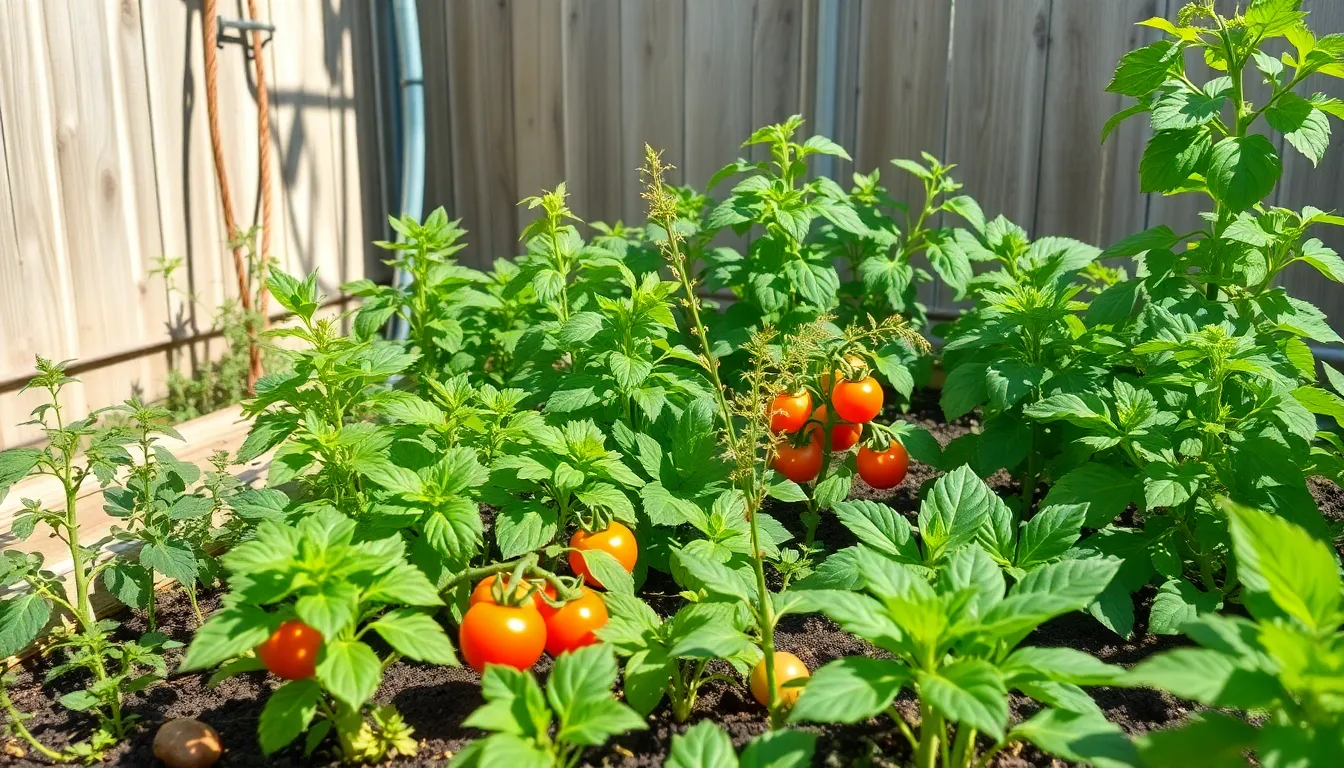
Strategic planning turns limited growing spaces into highly productive gardens while keeping costs minimal. We’ll maximize every square foot through thoughtful organization and efficient design choices.
Group Plants With Similar Water Needs
Clustering plants by their watering requirements dramatically reduces water waste and ensures healthier growth patterns. We recommend organizing drought tolerant herbs like rosemary, thyme, and oregano in one section since they thrive with minimal irrigation. Mediterranean vegetables such as tomatoes and peppers share similar moderate water needs and benefit from being grouped together.
Water loving plants including lettuce, spinach, and cilantro should occupy areas closest to your water source for convenient daily care. Installing a simple drip irrigation system costs under $30 and delivers water directly to plant roots while eliminating runoff and evaporation losses. This targeted approach can reduce water usage by up to 50% compared to overhead sprinklers.
Maximize Sun Exposure for Each Plant
Positioning plants according to their light requirements prevents competition and ensures optimal growth in compact spaces. We place sun hungry vegetables like tomatoes, peppers, and squash in south facing areas where they’ll receive 6-8 hours of direct sunlight daily.
Partial shade plants including lettuce, spinach, and most herbs flourish with 4-6 hours of morning sun followed by afternoon protection. Shade tolerant options like mint, parsley, and leafy greens work perfectly in areas receiving only 2-4 hours of filtered light. Observing your space throughout different times helps identify these varying light zones without expensive equipment.
Use Companion Planting to Save Space
Strategic plant partnerships maximize productivity while naturally controlling pests and improving soil health. The Three Sisters method combines corn stalks as natural supports for climbing beans while sprawling squash plants suppress weeds and retain soil moisture below.
Vertical companion planting utilizes trellises for climbing varieties like peas, cucumbers, and pole beans while shallow rooted crops such as lettuce, radishes, and herbs grow underneath. This layered approach can double your growing capacity within the same footprint.
Deep rooted plants like carrots and parsnips pair excellently with shallow rooted companions including onions and chives since they access different soil levels without competing for nutrients. Aromatic herbs planted throughout the garden naturally deter harmful insects while attracting beneficial pollinators to increase overall yields.
Conclusion
Creating a stunning small garden on a budget isn’t just possible—it’s an incredibly rewarding journey that transforms any space into a green oasis. We’ve shown you that with creativity and smart planning you can achieve remarkable results without very costly.
The key lies in combining multiple strategies: starting from seeds choosing high-yield plants repurposing everyday items and building community connections. Each approach reinforces the others creating a sustainable gardening system that keeps costs low while maximizing your harvest.
Remember that every successful garden starts with a single step. Whether you’re planting your first herbs on a windowsill or building raised beds from reclaimed wood your budget-friendly garden will provide fresh produce beautiful flowers and the satisfaction of growing something amazing with your own hands.
Frequently Asked Questions
Can I create a beautiful garden in a small space without spending a lot of money?
Yes, absolutely! Even small spaces like balconies, windowsills, and tiny backyards can be transformed into thriving gardens through smart planning and creativity. By repurposing household items as planters, starting with seeds instead of plants, and using free resources like compost materials, you can create a stunning garden on a tight budget.
What are the best plants to grow from seeds for beginners?
Fast-growing vegetables like radishes, lettuce, spinach, and bush beans are perfect for beginners. For flowers, try sunflowers, zinnias, marigolds, cosmos, and morning glories. Herbs like basil, cilantro, parsley, dill, and oregano are also excellent choices. These plants require minimal care and provide quick, satisfying results in small spaces.
How much money can I save by starting with seeds instead of plants?
Starting with seeds can save you 80-90% compared to buying established plants. A packet of seeds typically costs $2-3 and can produce dozens of plants, while a single seedling might cost $3-5. Plus, seeds offer access to a much wider variety of plants than what’s available at nurseries.
What household items can I repurpose as planters?
Old containers like plastic buckets, coffee cans, and yogurt containers make excellent planters. Vinyl gutters work great for herbs, wooden crates can become raised beds, and plastic bottles are perfect for vertical gardening. Even old dressers can serve as potting benches while providing storage underneath.
How do I start composting on a budget?
Build a simple three-bin composting system using wooden pallets for under $50. Start small with kitchen scraps like vegetable peels and coffee grounds. Use fallen leaves as brown material and maintain a proper carbon-nitrogen balance. Avoid meat and dairy to prevent pests, and shred materials for faster decomposition.
Which plants give the highest yield in small spaces?
Cherry tomatoes, especially ‘Sungold’ variety, produce abundantly when grown vertically. Herbs like basil and mint can be harvested regularly and multiply easily. Lettuce can be succession planted for continuous harvests, while chives and parsley self-seed and can be divided to create more plants for free.
How can I get free materials for my garden?
Participate in community plant swaps to exchange plants and cuttings. Collect seeds from existing gardens for future planting. Contact local tree services for free mulch delivery. Check salvage yards for reclaimed wood to build raised beds. Many communities also offer free compost programs.
What’s the best way to maximize vertical space in small gardens?
Install wall-mounted planters made from recycled materials to save floor space. Build trellis systems using bamboo or PVC pipes for climbing plants. Create tiered shelving systems to stack containers vertically. This approach can triple your growing capacity without requiring additional ground space.
How should I plan my garden layout for maximum efficiency?
Group plants with similar water needs together to reduce waste and ensure healthier growth. Position plants according to their light requirements to prevent competition. Use companion planting techniques like the Three Sisters method (corn, beans, squash) to maximize space and improve plant health naturally.
What are the benefits of building raised beds from recycled materials?
Raised beds improve drainage, extend the growing season, and make gardening easier on your back. Using reclaimed wood from salvage yards costs significantly less than new lumber. Old wooden crates and dismantled decking materials work perfectly for smaller beds, often costing just a fraction of store-bought options.

